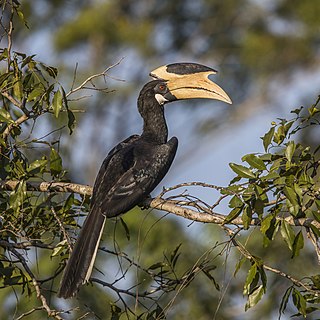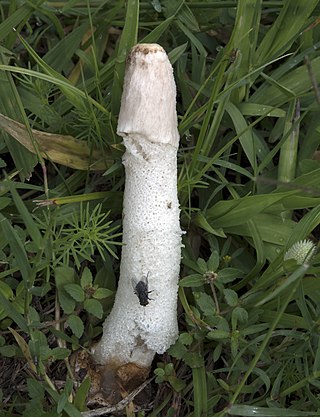
Phallaceae is a family of fungi, commonly known as stinkhorns, within the order Phallales. Stinkhorns have a worldwide distribution, but are especially prevalent in tropical regions. They are known for their foul-smelling, sticky spore masses, or gleba, borne on the end of a stalk called the receptaculum. The characteristic fruiting-body structure, a single, unbranched receptaculum with an externally attached gleba on the upper part, distinguishes the Phallaceae from other families in the Phallales. The spore mass typically smells of carrion or dung, and attracts flies, beetles and other insects to help disperse the spores. Although there is great diversity in body structure shape among the various genera, all species in the Phallaceae begin their development as oval or round structures known as "eggs". The appearance of Phallaceae is often sudden, as gleba can erupt from the underground egg and burst open within an hour. According to a 2008 estimate, the family contains 21 genera and 77 species.

The Malabar pied hornbill, also known as lesser pied hornbill, is a bird in the hornbill family, a family of tropical near-passerine birds found in the Old World.

The Shinto Kanamara Matsuri is an annual Japanese festival held each spring at the Kanayama Shrine in Kawasaki, Japan. The exact dates vary: the main festivities fall on the first Sunday in April. The phallus, as the central theme of the event, is reflected in illustrations, candy, carved vegetables, decorations, and a mikoshi parade. The shrine is part of the Wakamiya Hachimangu Shrine and located near Kawasaki-Daishi Station.

Carnoidea is a superfamily of Acalyptratae flies.

The Chaco eagle or crowned solitary eagle, is an endangered bird of prey from eastern and central South America. Typically it is known simply as the crowned eagle which leads to potential confusion with the African Stephanoaetus coronatus. Due to its rarity, not much is known about its biology or population.

The russet antshrike is a passerine bird in subfamily Myrmornithinae of family Thamnophilidae, the "typical antbirds". It is found in Mexico, every Central American country except El Salvador, Colombia, Ecuador, Venezuela, and possibly Peru.

A dildo is a sex toy, often explicitly phallic in appearance, intended for sexual penetration or other sexual activity during masturbation or with sex partners. Dildos can be made from a number of materials and shaped like an erect human penis. They are typically about the average length of an erect penis, 4–6 inches (10–15 cm), but some may be longer. A dildo's circumference is typically 4–5 inches (10–13 cm).

The genus Phallus, commonly known as stinkhorns, is a group of basidiomycetes which produce a phallic, often foul-scented mushroom, from which their name is derived. The genus has a widespread distribution and, according to a 2008 estimate, contains 18 species. They belong to the family Phallaceae in the order Phallales. The best known species is the common stinkhorn.

The crowned sandgrouse is a species of bird in the sandgrouse family, the Pteroclidae from North Africa and the Middle East.

The purple-crowned fairywren is a species of bird in the Australasian wren family, Maluridae. It is the largest of the eleven species in the genus Malurus and is endemic to northern Australia. The species name is derived from the Latin word cǒrōna meaning "crown", owing to the distinctive purple circle of crown feathers sported by breeding males. Genetic evidence shows that the purple-crowned fairywren is most closely related to the superb fairywren and splendid fairywren. Purple-crowned fairywrens can be distinguished from other fairywrens in northern Australia by the presence of cheek patches and the deep blue colour of their perky tails.

Hippocampus coronatus, commonly known as the high-crowned seahorse or crowned seahorse, is a species of fish of the family Syngnathidae. It is endemic to the Pacific coastal waters of Japan, where it lives among Zostera seagrasses. It can grow to lengths of 10.8 centimetres (4.3 in), but is more commonly 6 centimetres (2.4 in). Individuals feed mainly on small crustaceans such as gammarid amphipods and copepods, although this can vary by size, with smaller individuals consuming copepods while larger individuals feed on amphipods and mysids. This species is ovoviviparous, with males brooding eggs in a brood pouch before giving birth to live young. Breeding season occurs from June to November, with females and males reaching sexual maturity at 6.9 centimetres (2.7 in) and 7.3 centimetres (2.9 in) respectively. Male brood size ranges from 12–46. The International trade in this species has been monitored through Appendix II of the CITES licensing system since 2004 and a minimum size of 10 centimetres (3.9 in) applies to traded specimens.

Centrostephanus coronatus, also known as crowned sea urchin, is a species of sea urchin in the family Diadematidae. It was first described to science by Yale zoology Professor Addison Emery Verrill in 1867.

A phallus is a penis, an object that resembles a penis, or a mimetic image of an erect penis. In art history, a figure with an erect penis is described as ithyphallic.

In Greek mythology, Priapus is a minor rustic fertility god, protector of livestock, fruit plants, gardens, and male genitalia. Priapus is marked by his oversized, permanent erection, which gave rise to the medical term priapism. He became a popular figure in Roman erotic art and Latin literature, and is the subject of the often humorously obscene collection of verse called the Priapeia.
David P. Silverman is an American archaeologist and Egyptologist. He received an undergraduate degree from Rutgers University where he majored in art history. He later studied Egyptology as a graduate student at the University of Chicago where he received his PhD. Shortly after, he took a position at the international Treasures of Tutankhamun exhibit which originally ran from 1977 to 1982, and continued to work as curator on subsequent exhibits. Following this, he continued working at a variety of institutions including the Field Museum in Chicago. Since 1996, he has been Eckley Brinton Coxe, Jr. Professor of Egyptology at the University of Pennsylvania and head curator of the University of Pennsylvania Museum of Archaeology and Anthropology's Egyptian section. Alongside this, he currently teaches an online course through Coursera called Introduction to Ancient Egypt and Its Civilization. Some of his archaeological work has included excavations at Bersheh and Saqqara.

Hippocampus haema, the Korean seahorse, is a seahorse of the family Syngnathidae native to the northern Pacific Ocean, and it usually lives in Sargassum and weeds on shallow soft bottom habitats from 0 to 18 m depth. The Korean seahorse is the most common seahorse in Korean waters so that the scientific name 'haema' is named from 'seahorse' in Korean. The Japanese name 'Himetatsu' is derived from its smaller shape such as body and coronet rather than the shape of a sister species, crowned seahorse. This species had been repeatedly misidentified as crowned seahorse and Shiho's seahorse before a taxonomic review. However, the two genuine species do not live in Korean waters, therefore this species was handled by naming a new scientific name, Hippocampus haema. It can grow to lengths of 11 centimeters, but more commonly 6 to 8 centimeters as adult. Namely, the length of juvenile is 1 to 5 centimeters, whereas and the lengths of males and females reaching sexual maturity are considered as ca. 5 centimeters with or without male brood pouch. However, sex determination of this species is considered as ca. 2 centimeters from anatomic examination of gonad. This species has sexual dimorphism, the difference is male has a longer tail, while female has a longer trunk for same size. Breeding season of this species is from April to October or May to November, relating to warm water temperature. The number of fertilized egg or larvae inside the male brood pouch were 38.3±14.8 (20-76), and the number of fecundity identified from female were 47.2±8.6 (31-59). The female-to-male ratio was 1:1.7, indicating the dominance of males.
Phallus formosanus is a species of fungus belonging to the genus Phallus. It was documented in 1938.

Phallus granulosodenticulatus is a species of fungus belonging to the Phallus genus. It was discovered in 1832 in São Leopoldo, Brazil.

Phallus haitangensis is a species of fungus belonging to the Phallus genus. It was documented in 2016 in Yunnan, China. The species name "haitangensis" refers to Haitangwa, the name of the village in which the species was found. It was found on soil under Pinus armandii.
Cyrtolobus coronatus is a species of treehopper belonging to the family Membracidae.
















